If you’re planning to go bird-watching, you’ll need the right kit. A pair of really good binoculars, a cool hat, and if you haven’t thought of one before, a great bridge camera goes a long way for birding.
Bridge cameras are designed to give a wide zoom range and magnification and they’re more compact, so they’re great for venturing out with!
So which one is going to be right for you, you ask? Well, we have for you a selection of the best bridge cameras for birding out there. So stay tuned for your bridge camera soulmate, it’s right here!
Top 5 Bridge Cameras For Birding

Bridge cameras are becoming a popular essential in a bird watcher’s kit. So you want the best of the best to include in your birding gear. That’s why we curated a list of the top 5 bridge cameras for birding, and we’ve considered factors such as image quality, comfort, size, and definitely, price.
This list contains bridge cameras from the most popular and reputable brands, so you know you’re in good hands picking any of the five. From Nikon to Panasonic to Sony, we’ve got a selection of the ultimate greats just for you. Now without further ado, let’s get right into it.
1. Nikon COOLPIX P950
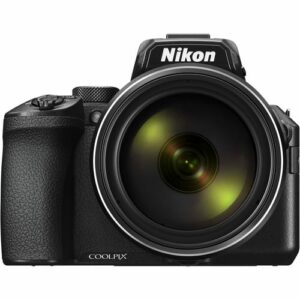
Made for outdoor photography, the Nikon COOLPIX P950 is powerful and compact.
The superzoom lens delivers 83x zoom and impeccable 4k quality videography, so you can effortlessly pick out intricate details on each bird.
The Nikon COOLPIX P950 retails at $796.95.
What We Like
The most striking feature of this camera is obviously, its enormous lens, and WE LOVE IT! The zoom-ins and outs are impressively smooth and versatile. Nikon’s reputation for being user-friendly stays true with this model.
What We Don’t Like
As you might expect, a large lens could mean it feels bulky and unfortunately, the P950 confirms that.
We’ve noticed the interface lagged a few times which can catch you off guard while shooting. Also, the autofocus is slow.
2. Nikon COOLPIX P1000
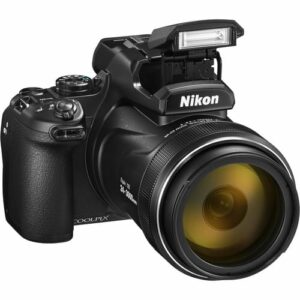
A 3000mm lens takes this bad boy to a whole new level of zooming. The dual detect image stabilization and OLED viewfinder make using this camera a total breeze.
The Nikon COOLPIX P1000 retails at $996.95.
What We Like
We love the zoom range on the P1000, the dual zoom controllers make it smooth to maneuver. The 4k video quality is also an impressive feature, with no crop. As usual, Nikon makes some of the most user-friendly gadgets and this is no different.
What We Don’t Like
Again with the bulky lens thing, we really hope Nikon considers this drawback. There is also no touchscreen panel to control, which in this day and age, is a major design flaw.
3. Canon PowerShot SX70 HS
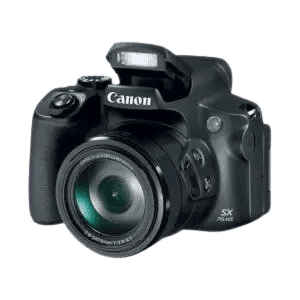
This particular model’s features truly make it a great wildlife and outdoor photography camera.
Thanks to its quick buffer and continuous shooting modes, you can capture life in motion. Whether it’s a lioness charging at a lone zebra or a hummingbird fluttering away.
The Canon PowerShot SX70 HS retails at $599.00.
What We Like
We love the long focal length on the SX70 and we’re very impressed with the fact that it doesn’t make the camera bulky.
It’s lightweight and comfortable to operate. We also prefer this over the other two above, if you’re into videography or vlogging.
Shooting speed and stabilization are also amazing.
What We Don’t Like
Sadly, this camera also lacks a touchscreen for controls. Low light image optimization is below par and while we love the long focal length, we understand that for some, it can be a tad bulky.
Especially if you’re going to be hiking up rough terrains and want to carry as little as possible with you.
4. Panasonic Lumix FZ80
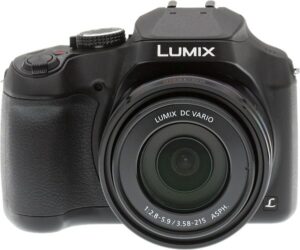
Now this is what you call a compact bridge camera! The Lumix FZ80 combines great images and portability that allows you to take this out on your birding hikes.
The Panasonic Lumix FZ80 retails at $397.99.
What We Like
The long zoom range is enough to sell us on this camera, the 60x wide angle zoom angle gives you a wide frame and shooting versatility.
It’s fast in shooting and also gets major points from us for its 4k video quality. The FZ80 is also the most affordable bridge camera on this list.
What We Don’t Like
The poor image quality in low light conditions truly disappoints the whole gadget and even for its affordable price tag, doesn’t satisfy. Also, it isn’t compact so this won’t be the best option to take along on bird-watching trips.
5. Sony CyberShot RX10IV
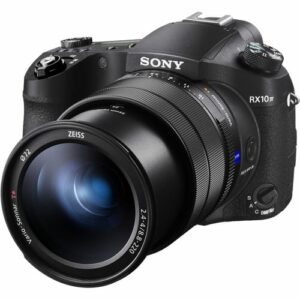
There was once a time when Sony CyberShots were everywhere because they were just so darn good.
Well, the RX10IV also makes for a quality contender for its digital camera ancestors. However, it is more outdoor shooting-friendly than it is selfie-friendly.
The Sony CyberShot RX10IV retails for $1698.00.
What We Like
If you’ve used a CyberShot you know how easy it was to use, and thankfully, the RX10IV is no different. With its simple touchscreen controls, you know what you’re doing.
It doesn’t compromise on its image quality either, with a phase detection AF system and optical stabilization giving you the best 4k quality visuals. The attachments, such as mic and headphones, and other built-in features, such as WiFi and Bluetooth are also seamless to use.
What We Don’t Like
Although it’s easy to use, sometimes the small buttons can feel a little too tiny, especially for someone with large hands and fingertips.
It can also feel a little bulky at times, especially if you’re using it outdoors for birding. The RX10IV is definitely the most expensive on this list, which can make it an unpopular choice.
What To Look For Before Buying A Bird Photography Camera
Okay now, before you go trotting off to buy your desired bridge camera to take along with you on your next bird-ventures, there are a few things you should know.
For a bridge camera to be great for your bird-watching necessities, consider taking a look at some factors your camera must meet.
You want the bridge camera to not only be great for shooting photos and videos, but it also needs to be easy to use, and compact enough to carry. Because after all, you’re going to take it on your birding hikes and trips.
So let us tell you some important things you need to consider when buying a bird photography camera,
Optical Zoom
You need to be able to zoom in and out with your camera when photographing birds. So go for a camera that has a strong optical zoom feature that lets you capture birds with utmost precision, clarity, and detail.
Look for a camera with a high zoom range so it’s versatile enough to shoot at wide frames with uncompromised quality. You want your lens to go out wide when photographing birds, this way, you’ll locate a variety of species at many, different distances.
Autofocus
The last thing you want is a camera with a poor autofocus feature, especially if you’re photographing birds. You need autofocus as it helps you capture the elusive creatures, who are otherwise in constant motion. A bad focus shot will miss out on intricate details and the natural beauty of birds.
So if you want a camera with a great autofocus feature, choose one that has phase detection or dual-pixel autofocus. These offer quick and precise tracking, locking onto the subject swiftly and still maintaining focus as it flies. Also, look for autofocus points, the more the better, allowing you to capture photos that are sharp and crisp.
You also want to consider autofocus speed, because with birds, you need to be ready at all times. A camera with a fast autofocus response will help you capture great photos even if the bird moves.
Some cameras have high-speed burst modes that take many frames per second, so you can choose from multiple options for good auto-focused photographs.
Autofocusing in low light conditions is also necessary to capture birds that fly through dusk and dawn. Good low-light autofocus features will help you still shoot sharp and bright photos even in dark conditions.
Image Stabilization
A camera with good image stabilization will help you take the best shots of your birding journey. Optical or sensor-shift image stabilization reduces blur even when/if your camera shakes.
A high ISO will shoot excellent photos even in low light conditions, besides taking amazing and crisp photos of the fast-movers that are birds.
You might also want to look for real-time feedback on image stabilization features on your camera.
There are some models that show the degree of stabilization on the viewfinder, allowing you to make quick adjustments or use other techniques to get the best photography results.
Coupled with great autofocus tech and zoom features, you’re set with a camera that is not only excellent for shooting birds and wildlife but is also amazing for casual and professional photography.
If you want to capture great videos of birds, consider the camera’s video stabilization. Tweak the features here and there to suit your video-capturing needs and requirements.
Frame Capture Rate
As for frame capture rates, the higher the rate will be, the better your photography will be. This determines how many images the camera will take per second.
A higher frame rate, like 10+ frames per second, will let you capture flying birds in sharp detail.
But remember that a higher FPS doesn’t always mean great photos. Sometimes a higher and faster FPS could mess with the resolution of pictures, so it’s best if you can test the camera at the store before buying.
And if you’re buying online, always rely on video reviews, they’ll always tell you everything you need to know.
Sensor Size
Sensor size is crucial, and the larger the sensor, the more light it captures, resulting in better image quality and low-light performance. Sensor sizes will also determine the dynamic range, which helps photograph details in both low and high light conditions.
Larger sensors will give you a better dynamic range which helps capture photos of birds better when the background is saturated or the subject is more detailed, which in the case of birds, is true.
Larger sensors also focus on the subject better with their shallow depth of field. Look for cameras with large sensors like APS-C or full frame.
FAQs
Are Bridge Cameras Any Good For Wildlife Photography?
Bridge cameras can be great for wildlife photography. They’re also pretty decent for beginners on a budget and relatively easy to work with. They have a good zoom range which is great for taking impressive close-up shots of wildlife.
How Is Bird Photography Different From Other Types Of Photography?
Bird photography is different from other types of photography in several ways,
1. Bird photographers need to work quickly and swiftly when capturing birds as they’re unpredictable and very active.
2. Bird photography needs long lenses to capture faraway subjects, so there is a learning curve when it comes to operating the camera.
3. Bird habitats or locations are diverse and can be challenging, so photographers need to adapt to various lighting and environmental conditions.
4. If you’re a bird photographer, patience is a non-negotiable trait you MUST master. You need to wait patiently for the right moment and learn the art of getting close enough to birds without scaring them away if you want decent photos.
5. You need a good knowledge of birds, of course. This will help you gauge different actions and behaviors of birds, so you can capture the perfect shot.
What’s The Best Time To Watch Birds?
The best time to watch birds is the early morning, between dawn and 11 AM. Late afternoons right before sunset are also a great time for bird-watching. Birds are very active in these times so they’re ideal for birdwatchers to indulge in their favorite activity.
Are DSLR Cameras Good For Bird Photography?
While not a popular choice, many bird and wildlife photographers prefer to shoot with a DSLR camera rather than a bridge camera. DSLR cameras have fast autofocus, interchangeable lenses, and a very impressive image quality.
DSLR cameras’ signature telephoto lenses are also great for photographers to shoot distant birds with detail and steadiness. DSLR cameras come with many accessories that are customizable and can help enhance the photos better than other cameras.
Which Phone Camera Is The Best For Bird Photography?
Samsung Galaxy’s S21 has an amazing camera with 108 megapixels, which can help capture a high level of detail and structure when photographing birds. iPhone cameras are also great for wildlife photography but they may not pick up on certain elements as well as Samsung Galaxy S21.
However, the iPhone exceeds Samsung at capturing photos and videos in low light conditions. It all comes down to the fact that smartphones, although have made their waves in the world, aren’t still as impeccable as professional cameras.
Conclusion
If you’re in the market looking for the best bridge camera for birding, you know which guide to go through. In case you need a hint, it’s this one. You’re not going to be disappointed by our selection of the best cameras.
We made this list keeping in mind the highest quality, make, and performance, so you can make an informed and wise decision without wasting money and time.
Share with your fellow birdwatcher friends and family so they can also get a heads up on a great bridge camera if they haven’t yet, or upgrade it if they already have one.

